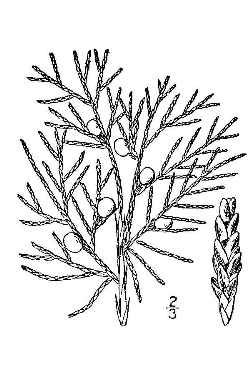
Britton, N.L., and A. Brown. 1913. Illustrated flora of the northern states and Canada. Vol. 1: 66. Courtesy of Kentucky Native Plant Society.
Sunset®: All zones
USDA: 2-9
Sun Exposure: Full sun to part shade
Origin: Eastern North America
Growth Habits: Evergreen tree, up to 30 to 40 feet tall (9-12 m), 10 to 20 feet spread, for the type, many dwarf cultivars exist; green to gray-green, 2 mm long, scale like leaves;
Watering Needs: Little water when established.
Propagation: Seeds, cuttings for the cultivars

@ USDA-NRCS PLANTS Database
Host plant for cedar apple rust. A number of people are allergic to the pollen of the Redcedar.
Propagation:
Eastern Redcedars are dioecious, but can occasionally be monoecious. Male trees have yellow-brown, catkin like cones, occurring in large groups. Female trees have waxy, light blue-green, berry-like cones, 0.25 inch in diameter (6 mm). The female cones start light green in spring, turning dark blue and glaucous in late summer as they mature. Full maturity being reached in September to November.
Desert-Tropicals is dedicated to provide gardening advice, gardening ideas, and information about flower of all kind for landscape and collections.We try to check carefully the identification of the plants on the illustrations as well as the other information from the page, but occasionally errors do occur. if you notice anything that needs to be changed please contact us.Thanks.
© 1998-2020 Philippe Faucon, All Rights Reserved.